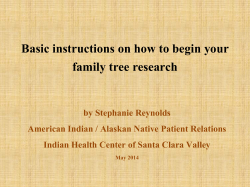
print version Nedra Reynolds` book, Geographies of
Review of Nedra Reynolds' Geographies of Writing: Inhabiting Places and Encountering Difference. David Rieder North Carolina State University print version Nedra Reynolds' book, Geographies of Writing, is destined to be an important contribution to the manifold ways in which studies of space and place impact the field of Rhetoric and Composition. In my estimation, her book will be an important point of reference for both academics and graduate students. The ways in which she weaves together critical and cultural geographical concerns with pertinent moments in our field's history will resonate with many researchers and practitioners of writing and rhetoric—especially researchers who are looking for ways to connect modern feminist composition theory to the rising, interdisciplinary interest in spatial studies. As I mention in my conclusion, I would have liked to see Reynolds push herself to articulate a more consistently materialist point-of-view. Nonetheless, this text will be an indispensable reference for those who, in their research, find themselves at the intersections of geography, composition pedagogy, feminist theory, and rhetorical theory. Reynold's first chapter is her longest, and her most provocative, perhaps because it can be read as an important revision and extension of arguments developed in her 2000 JAC article, "Who's Going to Cross This Border?" In her article, Reynolds critiques the metaphor of travel that Gregory Clark developed in his 1998 CCC article, "Writing as Travel, or Rhetoric on the Road." In his article, Clark is trying to find a way past two criticisms of theories of discourse communities: they are too static, and, related to this, they don't adequately account for change and movement among competing communities. Clark's proposed metaphor of travel is his attempt to break down or move beyond these kinds of discursive constraints. In her article-length response, Reynolds argues against the rising interest in journeying, border-crossing, and travel, because these "metaphorical" concerns do not adequately account for the materialist realities of place-based interaction. To this end, Reynolds argues that we can't ignore the ways in which our identities are bounded by the places in which we live and work. Extending her critique of Clark's non-materialist metaphor of travel to the broader themes developed in this book, Reynolds writes, "Composition studies . . . has not, typically, begun with the material but instead has been drawn to the metaphorical and the imaginary, particularly evident in language about texts and textual production" (12). In this chapter and others, an ambivalence emerges against the recent popularity of metaphors of movement in composition scholarship, for two reasons. First, metaphors of movement are not adequately grounded in a materialist method of study and critique. Second, these metaphors ignore a fundamental fact about movement: few people venture very far from the places in which they dwell, the places they call home. Especially for women and other minoritized subjects, Reynolds argues throughout her book, the freedom to change one's socio-cultural place is an arduous if not dangerous endeavor. Reynolds summarizes, "we need both movement and dwelling and . . . we must pay attention not only to borderlands but also to the places that borders surround" (13). In this chapter, Reynolds develops the grounds for this more balanced mode of attentiveness with the help of Henri Lefebvre and Edward W. Soja. Introducing Lefebvre's influence on her research, Reynolds writes, "Metaphor and material are often divided to make it easier to discuss or distinguish them, but their combination and interaction creates social space, Henri LeFebvre's term" (14). In her summary of LeFebvre's theory of social space (originally developed in his The Production of Space), Reynolds underscores the LeFebvrian idea that space is active, "not a passive surface" (15). LeFebvre's theory consists of three terms or modes: perceived, conceived, and lived space. After an explanation of the meaning of LeFebvre's schema, Reynolds concludes, "Trying to keep the three points of the triad straight is not as important, at least for my argument, as is maintaining a sense of their interlocked relation." (16). This point doubles as her transition to her second figure: Edward W. Soja. According to Reynolds, Soja's Thirdspace can be read as a "tribute to and an engagement with LeFebvre" (16). She writes, "Soja wants a 'trialects,' where the spatial and temporal are joined by the social. In a trialectics of spatiality, then, there is one blended, swirling concern with how space is lived, perceived, and conceived" (16). Reynolds continues: The trialectics of space leaves binary concepts, like insider-outsider, floating in the middle or bouncing from one spot to another; thirdspace means exploding or transgressing binaries, not simply flipping them to restore the undervalued term. Lived, perceived, and conceived space fold into and spin across one another, working together to accomplish the production of space. (16) Although I would have liked to see Reynolds take Soja at his word, moving beyond her own movement-dwelling binary, in this particular chapter, Soja and LeFebvre serve her well. Moreover, Reynolds is able to tie these two theorists' contributions to the work of a number of compositionists like Linda Brodkey, Deborah Brandt, Linda Haas, Anne Aronson, and Richard Marback—all of whom have focused on the materiality of space and place in some or all of their scholarship. Chapter two opens with a description of the fall and subsequent rise of interest in geographical studies in the United States. Reynolds writes, "World War II marked a peak in geographic interest, which fell off again until the recent renaissance of geography" (50). The renaissance, Reynolds explains, is due to the increasingly global character of economics, politics, and communication. The opening sections of the chapter also include definitions of two schools of geographical study, physical and human geography. Ultimately, she focuses her attention on human geography, about which she writes, "according to some commentators, human geography's most significant contribution may well be to insist on the materiality of the terms place, space, landscape, and location'" (52). Related to this point, Reynolds references a number of contemporary cultural geographers, who, informed by the work of theorists like Raymond Williams and Pierre Bourdieu, recognize that the relations between a place and its inhabitants are inextricably linked to the sensed or affective dimensions of knowledge. But Reynolds doesn't turn to the question of materialism. Rather, she explains that geography is "very much a seeing discipline" (53). In the second half of the chapter, Reynolds extends the theme of visuality to composition studies. Summarizing individual works by Johndan JohnsonEilola, Gunther Kress, Christina Haas, and Lester Faigley, she argues that these scholars have demonstrated "that those who study writing can no longer afford to ignore visual and material elements of communication" (68). Transitioning from this claim, Reynolds begins to develop a connection between pedestrian spaces and on-screen space. Playing off of Walter Benjamin's description of the flaneur as the paradigmatic urban dweller, Reynolds writes, "A contemporary flaneur would be as much 'at home' in screen culture as on familiar streets, practicing many of the same moves of a confident and curious street dweller, with keen attentiveness to the environment and an eye out for anything 'new'" (74-5). In the opening pages of chapter three, Reynolds writes about the concept of mental or cognitive mapping, citing the ideas and methods of theorists like Kevin Lynch, William Least Heat-Moon, and, in our own field, Ralph Cintron. According to Reynolds, these two concepts represent a person's capacity to understand her relationships with fellow inhabitants —as well as to tacitly negotiate the spatial distances and directions by which those relationships are framed. Reynolds writes, "It's the ability to carry around in our heads organized information or images of cities. . . . We have mental maps of our hometowns or the most familiar places of our childhoods; we have mental maps of our current neighborhoods or campuses" (82). Related to these definitions, Reynolds underscores the socially constructed character of "mental maps," leading her to conclude that these maps are not cognitive but social. Moreover, echoing the theme of metaphor and imagination in chapter one, Reynolds writes, "[Mental maps] are a particular form of 'imagined geography' that illustrate the complex relationships between the social and the spatial" (84). Leading into the main part of the chapter, Reynolds underscores the pedagogical use of mental mapping, arguing that studies of personal maps can be used to explore issues related to gender, class, and personal identity. The centerpiece of chapter three is a series of interviews with eight thirdyear students in the Leeds geography program. The students, participating in a workshop in the spring of 2000, were asked "to do a version of a mental mapping exercise as a sort of pre-writing activity to their research project on a place new to their experience" (87). Students were paired up and provided with an Ordinance Survey map of Leeds. They were asked to identify four types of areas on the map: no-go, ethnic, conflict, and normal. Students used color markers to shade in or outline the different types of areas. Reynolds frames the value of her interviews with the eight students in two ways. First, her interviews dramatize the ways in which we explore a "geographical rhetoric," which she describes as follows at the end of the chapter: "A geographical rhetoric . . . [tries] to capture the layers of meaning and the feelings of residents or visitors or trespassers. Contested places . . . in Leeds are not easily 'mapped,' but as rhetoricians and educators, it is our responsibility to understand not only where our students come from but also what forms of fear or reluctance keep students locked in place" (109). Second—and related to the preceding quote—her interviews demonstrate the degree to which dwelling is just as important if not more important than movement. Quoting Geraldine Pratt and Susan Hanson's "Geography and the Construction of Difference," Reynolds underscores the following reality: "'Although the world is indeed increasingly well connected, we must hold this in balance with the observation that most people live intensely local lives'" (89; Reynolds' emphasis). In her interviews, the students' comments dramatize the extent to which "spaces of ambiguity" are expressive of the blurring of the boundaries among paired categories like inside/outside, public/private, and home/street. The gender, ethnicity, age, and personal history of the students are written across the maps that they shaded with their colored markers, creating a rich opportunity for studies of socially constructed notions of space and identity. Chapter four extends the initial research conducted in chapter three. Reynolds joins two groups of students as they leave the classroom for the field to gather socio-cultural, geographical data about two locations in and around Leeds. The first group studied a rural village on the outskirts of Leeds called Eccup. The second group surveyed the Leeds Financial District. At the end of an introduction in which Reynolds writes about "difference" and the allure that the street has generated in recent theory and practice related to this concept, she concludes, "Of all cultural locations, the street is perhaps the most contested, the most up for grabs, and the most provocative" (110). Reynolds cites the "rich literature" about the street that has been developed in fields like geography, urban studies, architecture, and cultural theory. Citing David Crouch's studies of "folk" and "ordinary" street life, Reynolds concludes, "[S]treets become 'embodied' with stories, memories, and all sorts of meanings" (110). And, "Whether it's a rhetoric of walking in the city (de Certeau) or the battle cry of taking to the streets in protest, the street holds tremendous metaphoric power and captures our imagination" (111). But after citing some of the excitement that attends much of the "street level" theory and practice that she references, Reynolds reminds us that streets also "represent sites of fear and vulnerability, especially for women" (111). As we are led from her introduction to the main focus of the chapter, the following claim helps underscore Reynolds' concerns: "[T]his chapter argues that the 'academic enthusiasm for difference' must be tempered by the sociospatial realities of everyday life" (113). After a summary of the activities and initial reactions that both groups experienced, Reynolds explains, "The 'nature' of [Eccup and the Leeds Financial District] led students to concentrate on different modes of interpretation. The Eccup group . . . became increasingly interested in history while the financial district group was more interested in architecture and postmodernism" (127). Interestingly, the Eccup group was surprised to realize that the village did not match their imagined geography of rural English life. Reynolds writes, "Before their initial visit, students in the Eccup group imagined a homey, close-knit village with a pub and a shop as the centers of interaction" (130). What they found was a town without a clear sense of meaning, which led one of the group's participants to state, "There is no culture here" (121). For this reason, Reynolds explains, the Eccup group tended to focus on interviews with local residents to gather research, whereas the Financial District group "concentrated almost exclusively on the built environment" (127). Although I hoped to see Reynolds delve even more deeply in to the implications of her participant-observer research, connecting it more richly to the theoretical premises of Lefebvre and Soja, her conclusions are insightful and very useful for compositionists interested in placebased initiatives—especially as they relate to the interest in exploring place-based, socio-cultural difference. Moreover, at the end of chapter four, Reynolds turns to our field's interest in service learning. Her studies of the limitations found in the two group's research in and around London provide a provocative basis for Reynolds to question the ethical and political dimensions of service learning. Turning to feminist research methods, Reynolds explains that some feminist researchers "try to involve willing 'participants' rather than examine 'subjects' and try to remain conscious of the problems with imposing one's own agenda" (137). Her point is that this "alternative" method may help move beyond some of the distanced methods used in geographical research. In her final chapter, Reynolds reinforces many of the themes with which she has been working. She reintroduces several of the theorists upon whom she has relied, including Linda McDowell, Adrienne Rich, and bell hooks. Moreover, Reynolds includes a section on Martin Heidegger's concept of dwelling, Gaston Bachelard's topoanalysis of the same concept in his The Poetics of Space, and a few brief allusions to Bourdieu's theory of habitus. In Reynolds' attempt to move beyond binaric categories like inside/outside, subject/other, she turns to feminist theory, writing, "For feminist theorists, beginning with the body as the geography closest in is a way of resisting patriarchal epistemologies that insist on objectivity or subscribe to a Cartesian mind-body split" (144). One of the imperatives implied in this statement is to move beyond the kinds of place-based methodologies that do not adequately address the spaces that one brings with them as they negotiate sociospatial difference. Reinforcing this imperative, Reynolds writes, "Understanding how geographies are embodied—how bodies imprint a place with identifiable or palpable characteristics —can lead to an inquiry into why some bodies feel excluded from certain places or how the social production of space operates via keeping some bodies in and some bodies out" (145). Turning to pedagogical issues, Reynolds underscores the importance of place on learning and on writing. She claims, "For re-imagining the work of writing through both the places and practices of dwelling, it's necessary to begin with mapping some of our most familiar spaces" (158). The second half of the chapter combines anecdotal evidence of place-based experiences at Reynolds' home institution, the University of Rhode Island, the data collected at Leeds University, and recent debates in composition studies about textual access. Alluding to the experience of the Financial District Group at Leeds University, Reynolds writes, "Within the discourses of composition studies, which are often written in response to or from intersections of various postmodern or critical theories, readers from different neighborhoods, if you will, disagree about whether dense theoretical writing has the equivalent of bars on the windows or signs saying 'Proper dress required'" (164). Citing the debate between Wendy Bishop and Gary Olson about theory in composition as well as Sharon Crowley's contribution to the discussion, Reynolds writes, "The Bishop and Crowley exchange over the density of prose offers an opportunity to deepen our understanding of textual geographies of exclusion" (166). Related to this debate—as well as to another section of her chapter in which Reynolds explores the implications of PowerPoint and other "texts" in which students are asked to dwell as writers— Reynolds writes, "Whether the geography of difference is constructed in a journal article, a book, a classroom, a town, a housing estate, or a city neighborhood, we can cultivate spatial practices that advocate dwelling as well as walking and mapping" (174). Reynolds' book contains within its own borders a fascinating and important contribution to the emerging focus on space and place in composition studies. Although I would have liked to see her "thicken" her analyses in chapters three and four, her first and last chapters in particular are compelling to read. Reynolds has developed a book within which many composition scholars and graduate students will want to "dwell." And yet, her book is also expressive of some of the ongoing limitations in our field's methodologies. Specifically, Reynolds' human-centric standpoint holds her back from achieving the materialist perspective with which she starts. I understand and appreciate why she upholds this humanism. Importantly, it is expressive of her concerns as a feminist researcher, who feels that the "posthuman" geographies in contemporary philosophy and theory do not adequately address issues of access and exclusion. Nonetheless, her own humanism traps her at the limits of the very system of dualistic analyses against which she writes in her first chapter. In other words, the human-centric standpoint with which she works recreates the very grounds against the new that persist in our field. Works Cited Clark, Gregory. "Writing as Travel, or Rhetoric on the Road." CCC 49(1998): 9-23. Lefebvre, Henri. The Production of Space. Trans. Donald NichlosonSmith. London: Blackwell Publishers, 2000. Reynolds, Nedra. Geographies of Writing: Inhabiting Places and Encountering Difference. Carbondale: Southern Illinois University Press, 2004. - - - . ""Who's Going to Cross This Border? Travel Metaphors, Material Conditions, and Contested Places." JAC 20 (2000): 541-64. Soja, Edward W. Thirdslace: Journeys to Los Angeles and other RealAnd-Imagined Places. London: Blackwell Publishers, 1996. Citation Format: Rieder, David. Rev. of Geographies of Writing: Inhabiting Places and Encountering Difference by Nedra Reynolds. Enculturation 5.2 (2004): http://enculturation.gmu.edu/5_2/rieder.html Contact Information: David Rieder, North Carolina State University Email: dmrieder@unity.ncsu.edu Home Page: http://www4.ncsu.edu/~dmrieder Home | About | Editors | Issues Submissions | Subscribe | Copyright | Review | Links
© Copyright 2025









